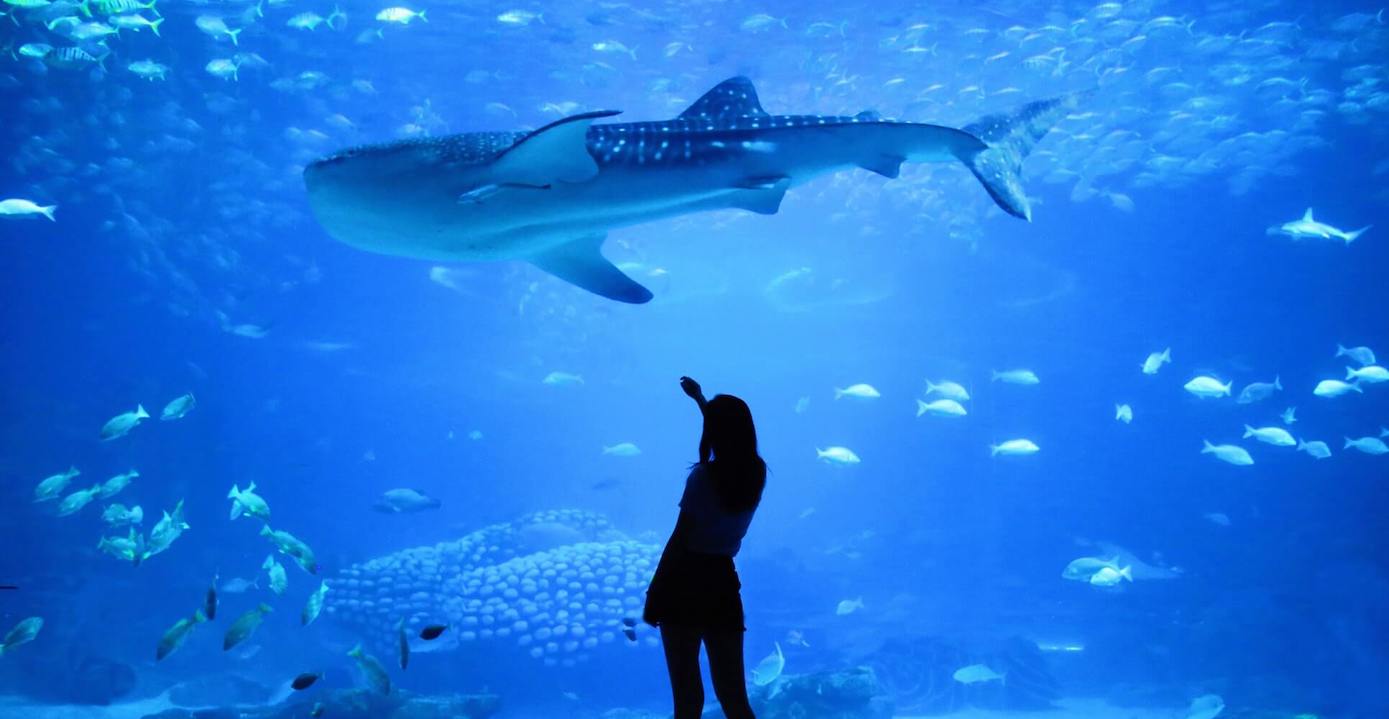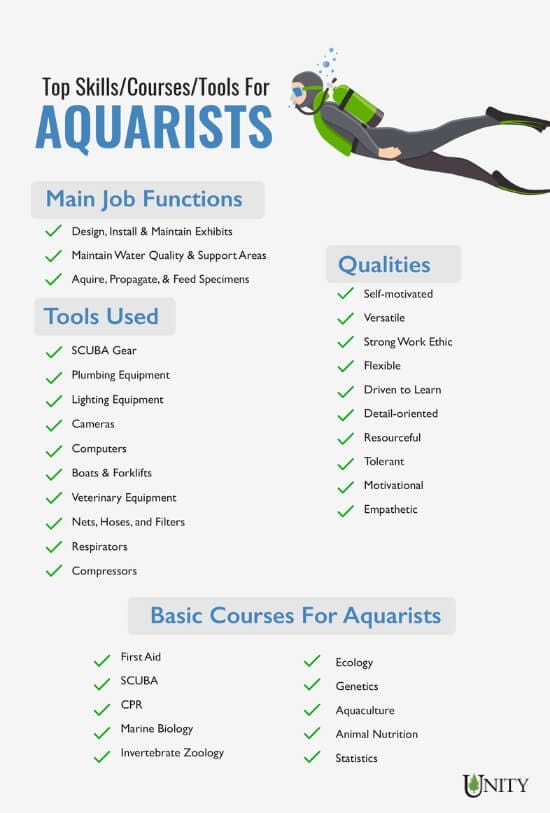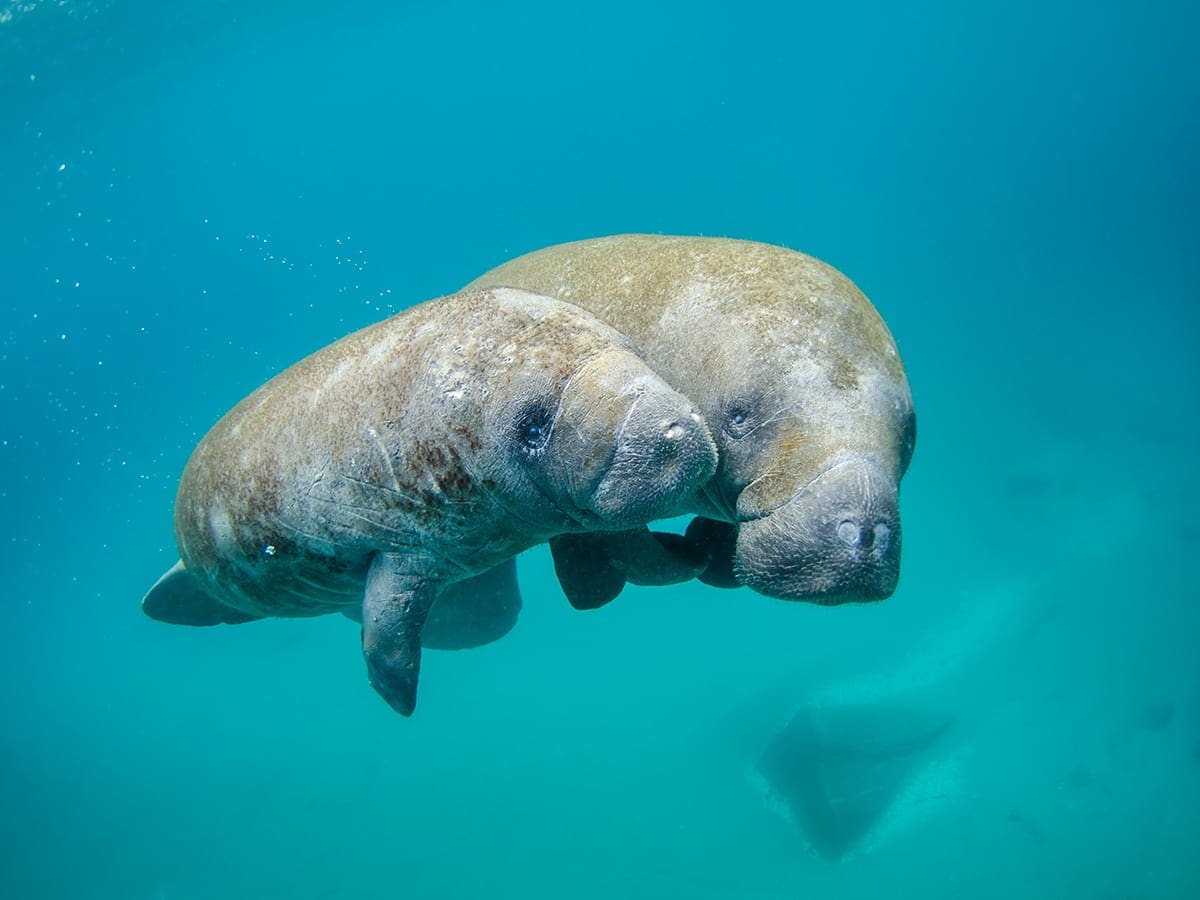
What is an Aquarist And How to Become One
What most don’t realize is how intricate an aquarium’s systems are, and how delicate the balances of the species can be that it encloses. It takes a highly specialized and dedicated team of individuals to monitor an aquarium, ensuring the health and stability of the creatures that spectators love to see. This is the job of an aquarist.
- What is an Aquarist?
- Work Environments
- Key Tasks & Duties
- Salaries for Aquarists
- Job Outlook & Growth Rate
- Educational Requirements
- Related Degrees

What is an Aquarist?
An aquarist, by definition, is a person who keeps an aquarium. However, someone in this role would agree that it’s much more challenging than cleaning the average household goldfish bowl.
A professional aquarist is responsible for the caretaking of fish and underwater animals. In this role, the caretaker monitors the animals’ diets, oversees tank cleanliness, and recognizes signs of sickness or distress.
Even though the animals that come along with working in an aquarium can be untraditional and rather ugly in appearance, an aquarist should still have a passion for the wellbeing of their creatures.
In this position, a person should strive to make an animal’s life in captivity as seamless to life in the wild as possible.
Where do Aquarists Work?
An aquarist can work in a variety of settings, the most obvious of which is at an aquarium (a facility where aquatic animals are kept in captivity to educate the public).
They can also be found in zoos, wildlife sanctuaries, or the outdoors doing fieldwork.

Aquarists in the Field
While most aquarists work in an indoor facility overseeing animals, some travel out into the field (such as a river, lake, or ocean) to gather or study specimens.
This is a perfect opportunity for prospective aquarists who want an outdoorsy element built into their roles as an aquarium biologist.
However, it’s important to consider the challenges in day-to-day work life that being in the field may bring.
There is often more travel required, the hours can be more sporadic, and there may be additional training outside of an aquarist’s pre-existing qualifications to observe aquatic specimens, such as deep-sea diving.
Aquarists in the Office
A professional working in an aquarium may work specifically with one tank or set of tanks, such as sharks or crustaceans. Alternatively, they may get to cycle through all of the departments in the aquarium as their skills allow.
Aquarists expect some desk work in their average workweek, too. There are reports that need to be written on subjects like tank water conditions and animal health.
Flexibility is one of the requirements to work at an aquarium, however; most are open six, if not seven, days a week, from late morning to early evening. The team of aquarists needs to come in before the facility opens to feed and check on the sea creatures – and will do the same at closing time.
As animals are living beings, their needs are constant. Aquarists must work even when the facility is closed to feed and care for the fish and may find themselves responding to emergencies at the aquarium at night.
Aquarist Job Description
What does an aquarist do? A typical day in the life of an aquarist contains a wide variety of different tasks, which can go beyond the basic aquarium tank cleaner job. Caretakers of aquatic animals have lots of tabs to keep track of, including:
- Policing water quality
- Fish tank maintenance jobs
- Equipment repair
- Presenting to aquarium patrons
- Observing animal behavior, and more
Some niches of the aquarist role can branch off into marine biology, a very close relative to the profession.
Becoming a marine biologist requires a lot of the same skills needed to be an aquarist.
Junior Aquarist Job Description
On the entry-level, there is a lot that junior aquarists do to grow their skills in the field. Junior-level employees might be college students taking aquarist courses, or recent college graduates acting as assistants to more seasoned aquarists.
These positions are often part-time internships or volunteering opportunities for new and aspiring aquarists looking to expand their resume.
Here are a few examples of some of the day-to-day tasks that are part of a junior aquarium technician’s job description:
- Clean tanks and perform daily tank maintenance
- Prepare food for animals under the nutrition plan of a senior aquarist
- Collect data on water substance levels and temperature levels, and deliver to a senior aquarist
- Mentally stimulate more intelligent species with activities and toys
- Administer vitamins and medicines per the instruction of a senior aquarist
- Check functionality of and perform servicing on life support machinery such as filters, heaters, and pumps
- Assist in transporting animals from tank to tank as needed for medical attention, relocation, or cleaning
- Logs changes in animal diet, demeanor, activity, or appearance for reporting to a senior aquarist
- Deliver presentations to aquarium patrons
- Assist senior aquarist with research
Senior Aquarist Job Description
A senior aquarist is a more experienced role in the marine biology field. This professional may be responsible for tasking junior aquarists with jobs, responding to data from daily aquarium activity, and seeing that the health and wellbeing of the aquatic animals are addressed.
During a typical workday, a senior aquarist or aquarium director’s job description might include:
- Write or edit an animal’s nutrition plan, including the type of food to administer, how much, and when
- Use data on water substance and temperature levels collected by junior aquarists to adjust accordingly for animal comfort
- Identify toys and activities that may stimulate more intelligent species, and instruct juniors to use them
- Diagnose aquatic animals who require medicine or vitamins
- Research and identify new species that should be brought to the aquarium
- Travel to oceans, rivers, or lakes to collect or observe new specimens
- Respond to observations by junior aquarists of abnormal animal appearance and activity
- Order animals to be removed from the tank when there is a need for relocation, medical attention, or cleaning
- Prepare presentations to be delivered to aquarium patrons
- Initiate and lead relevant research projects
How Much do Aquarists Make?
While there may be some full-time aquarist opportunities out there, it’s important to note that the schedule and demands of the job more commonly call for part-time work. As with most professions, those who are interested in this field might be banking their decision on the average aquarist salary.
According to the US Bureau of Labor Statistics (BLS) in 2018, the average salary for an aquarist was just under $24,000 a year, or $11.51 per hour, when with ‘Animal Care and Service Workers’. This is a roughly $1,000 increase from the same data collected a year prior.
More specifically, the average pay for aquarists is $34,000, according to Payscale.com. This means that the average hourly pay for an aquarist is around $14.
The average pay varies from state to state, but some of the notable highest paying states include the District of Columbia and Washington. Arkansas and Idaho are among the lowest-paying states for aquarists.
Senior and Junior Aquarists’ Salaries
The BLS doesn’t survey the earnings of a more specific list of aquarium jobs, such as an aquarium technician salary. However, as expected with most career fields, the more experienced or specialized the professional, the higher the salary.
Aquarists who advance into different roles will likely see higher pay in figures such as a senior aquarist salary or aquarium curator salary.
Other reports find that the top tier of aquarist pay, such as senior aquarists, averages around $32,500 annually, with the lower portion of the spectrum coming in at just under $16,500.
What is the Job Demand for an Aquarist?
The BLS has good news for aspiring aquarists:
The field of animal care and service workers, including aquarists, is projected to grow by 16% over the next decade or so. This is a much faster average rate than other professions. For aspiring aquarists, this means more opportunities for getting hired in the specific field of choice.
Surveyors anticipate more than 50,000 jobs will be added to the field over the coming years.
That information, combined with the higher turnover rate of aquarium jobs with more menial duties, leads to a very positive outlook for graduates of aquarist colleges looking to dive right into the world of underwater animal care.
What Qualifications do I Need to be an Aquarist?
Marine biology jobs in aquariums are specialized positions. There are education and internship experiences that are generally required before a person can be successful in this role.
Someone who is hoping to land in the aquarist position should plan on getting an aquarium science degree and completing an internship program first.
In this section, we’ll cover the aquarist education and training requirements, so you will know exactly how to get a job at a zoo or aquarium.
How Long does it Take to Become an Aquarist?
This depends on how much training a prospective aquarist decides to take on at a time. At a minimum, students need to have a four-year bachelor’s degree in a field such as zoology, marine biology, aquaculture, or a similar program.
Students can decide to overlap some of the training requirements of becoming an aquarist to save time, such as internships and scuba diving training. It goes without saying that if someone chooses to go through these programs one at a time, it will take longer for them to reach the end of the entry-level portion of the career. Internships can range in length from six weeks to a year.
Internships can often be completed while still in school, which gives aspiring aquarists more of an edge on their resumes entering the job world.
Progressing from the junior to senior aquarist role can take, on average, three to five years of further experience, plus the relevant additional training.
Aquarist High School Requirements
What does it take to work at an aquarium? Especially in more competitive regions, the answer begins at the high school level. Students should immediately begin tailoring their fields of study with anything that has to do with animals, and in particular marine animals, if possible.
Higher education programs also value a stellar academic record, and extracurriculars having to do with animals, agriculture, and ecosystems.
Extracurriculars for aspiring aquarists in high school can include:
- National FFA Organization
- A conservation club
- Or raising livestock
Undergraduate Aquarist Education Requirements
Future aquarists should plan to be in college for four years, at least. To be successful as an aquarist, plan on completing a bachelor’s of science degree. Good choices include a B.S. in Animal Health and Behavior, an Online B.S. in Marine Biology and Sustainable Aquaculture or a B.S. in Marine Biology Degree.
While higher education degrees such as masters and doctorates certainly wouldn’t harm an aquarist career, surveys show that a bachelor’s degree is sufficient to enter the field.
More specialized roles and senior positions, however, like those in laboratories, fieldwork, and research may require upper-level degrees among their aquarist education qualifications to compete with other highly qualified aquarists.
Related Degrees and Courses for Aspiring Aquarists
- Online B.S. in Marine Biology and Sustainable Aquaculture: In this aquarium science degree online, students learn the biological connections between the world’s oceans, the promise and future of the aquaculture industry, and how we can all contribute to a sustainable marine environment.
- B.S. in Marine Biology Degree: This major empowers students fascinated by living sea organisms to pursue their passion with hands-on experience. Wondering what else you can do with a degree in marine biology? Read our full guide.
- B.S. in Conservation Biology: An emerging and relevant transdisciplinary field in which students study aspects of biology through a conservation lens with the goal of protecting biodiversity in all forms, including aquaculture.
- B.S. in Animal Health and Behavior: This degree from Unity Environmental University prepares students for careers at zoos and aquariums, in the veterinary fields, as animal welfare officers, and for a future-focused on the care and well-being of wild and captive animals around the world.
- B.S. in Wildlife and Fisheries Management: The fisheries concentration allows graduates additional opportunity with cultured food and industrial products such as algae, shellfish, crustaceans, and finfish.

Ready To Learn More About Unity Environmental University?
Additional Certifications and Licenses
Aquarists must have scuba diving certification to care for underwater animals.
Additionally, it’s a good idea for aquarists to have CPR training when working with people who go underwater.
Senior aquarists who venture out into the field may need experience in deep-sea diving to observe specimens.
Societies, Professional Organizations, and Resources For Aquarists
Aquarists from all over can join the Association of Zoos and Aquariums, a non-profit organization that provides resources for aquariums and animal professionals.
Aquarists can network with others to share conversation, education, and science ideas.
The organization keeps aquarists up to date on relevant news, publications, and new resources. Most other aquarist societies are locally based by state or region.
Is Being an Aquarist Right for You?
If you like the idea of caring for underwater animals, designing new habitats, and working with like-minded professionals in an aquarium, it might just be the perfect career for you.
As long as you’re willing to put in the time and effort for an aquarist degree, the career can be rewarding in the long run. Reach out to admissions today to discuss your degree options.
Degree Programs
Degree programs
to match your passion
z







